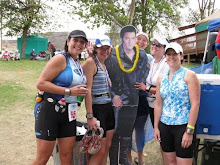Problem is, if you don't take time for proper R&R, your body won't adapt to the stress of your training—you won't get stronger or faster, explains Stacy Sims, Ph.D., at the Stanford Prevention-Research Center, School of Medicine. Neglect recovery for too long, and you will start to lose strength and speed. You'll sink into the black hole known as overtraining.
First, your sleep patterns and energy levels will feel the effects. Eventually, your immune system crashes, and you lose your appetite. It's like burning out your engine. And you don't have to be logging 100-mile weeks to suffer. Recreational runners can overtrain, too. "With deadlines, chores, bills, kids, and lack of sleep, it's more challenging to recover properly from your runs," says Sims.
So in preparation for the 2011 Boston Marathon, Hall used an online recovery-tracking program called Restwise, which looks at simple biological markers input by the athlete first thing each morning, calculates a daily recovery score from 1 to 100, then trends it over time. (Rest-wise subscriptions start at $119 for six months; go to restwise.com.)
Pay attention to the following 10 markers. If three or more of these indicators raise a red flag, you should consider a few easy sessions or off days so you can return to running strong (see box, right). Says Hall, "Now I'm learning to love to rest."
1 BODY MASS: You lost weight from yesterday
A two percent drop in weight from one day to the next indicates a body-fluid fluctuation. Most likely, you didn't hydrate enough during or after your last workout. Dehydration negatively impacts both physical and mental performance, and could compromise the quality of your next workout.
2 RESTING HEART RATE: Your resting heart rate is elevated
Take your pulse each morning before you get out of bed to find what's normal for you. An elevated resting heart rate is one sign of stress. It means your nervous system prepared for fight or flight by releasing hormones that sped up your heart to move more oxygen to the muscles and brain. Your body won't know the difference between physical and psychological stress. A hard run and a hard day at work both require extra recovery.
3 SLEEP: You didn't sleep well or enough
A pattern of consistently good sleep will give you a boost of growth hormones, which are great for rebuilding muscle fibers. Several nights in a row of bad sleep will decrease reaction time along with immune, motor, and cognitive functions—not a good combination for a workout.
4 HYDRATION: Your pee is dark yellow
This can be an indicator of dehydration, barring the consumption of vitamins, supplements, or certain foods the evening before. The darker the color, the more you're struggling to retain fluids, because there's not enough to go around. You need H2O to operate (and recover).
5 ENERGY LEVEL: You're run down
If your energy level is low, there's something amiss. The key is honesty. Athletes can block out signs of fatigue to push through it, thinking it will make them stronger. It won't always work that way.
6 MOOD STATE: You're cranky
When your body is overwhelmed by training (or other stressors), it produces hormones like cortisol that can cause irritability or anxiety. Stress also halts chemicals like dopamine, a neurotransmitter in the brain that has a big bummer effect on mood when depleted. Crankiness probably means not enough recovery.
7 WELLNESS: You're sick
Any illness, or even a woman's menstrual cycle, will increase your need for energy to refuel your immune system, which is having to work overtime. This means fewer resources available for recovering from training.
8 PAIN: You're sore or nursing an injury
Whether you're sore from overworked muscles or an injury, your body needs more energy to put toward repair, lengthening total recovery time.
9 PERFORMANCE: Your workout went poorly
This is a subjective measure of workout quality, not quantity nor intensity. If you felt great on yesterday's run, you'd evaluate that as good. If you felt sluggish on that same run, you'd count it as poor. Trending workout quality—multiple poors in a row—is one of the easiest ways to identify the need for more recovery.
10 OXYGEN SATURATION: Your oxygen level has dipped
The amount of oxygen in the hemoglobin of the red blood cells can be measured by placing your fingertip in a portable pulse oximeter, a gadget available online for about $40. The higher the percentage, the better: Above 95 percent is the norm at sea level or for an athlete who is fully acclimated to a given altitude. This is a new area in recovery science, requiring more research, but there may be a link between low oxygen saturation and the need for more recovery.
Count Your Red Flags
The restwise algorithm assigns more weight to some markers (e.g., performance) than others (e.g., mood), along with other factors to generate a precise recovery score. But you can get a sense for your ballpark recovery quality by tallying the red flags (left) you average per day in a week.
0-1 GREEN LIGHT
You are clear to train hard.
2-4 CAUTION
You can go ahead with a hard workout if your training plan calls for it, but cut it short if it feels too hard. Better yet, take an easy day, or a day off.
5-6 WARNING
You're entering the danger zone, which could be intentional according to your periodization or peaking protocol. If not, back off.
7-10 DANGER
You require mandatory time off, ranging from a day to a week, depending on the severity of your fatigue and what you've seen over the previous few days and weeks. You may need to visit your doctor.
FEEL Better: Too much rest has its own problems: Your performance stalls. On your recovery days, do something active; go for a bike ride, walk, or do yoga.
MUSCLES NEED 48 HOURS TO RECOVER AFTER AN INTENSE RUN. DURING THIS TIME, CELLS ARE REPROGRAMMED TO BE STRONGER.





















